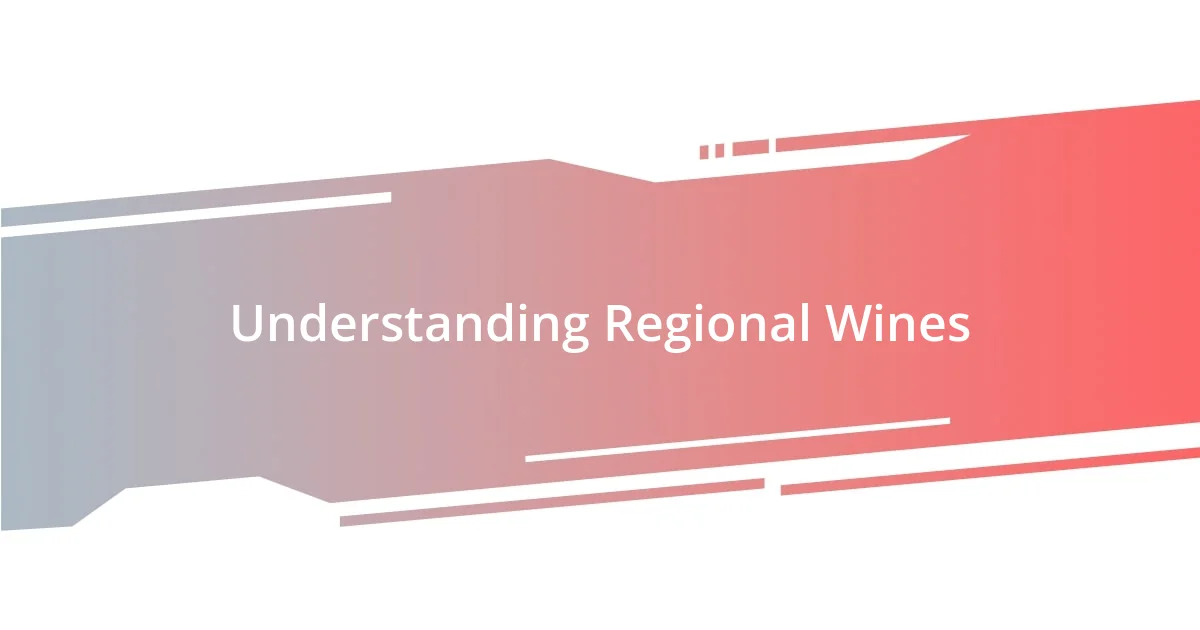Key takeaways:
- Regional wines reflect the terroir and cultural stories of their origins, fostering community among winemakers.
- Effective food pairings enhance the wine experience by matching intensity, acidity, and regional ingredients.
- Local wine trends showcase sustainable practices and experimental blends, offering unique flavors that highlight winemakers’ journeys and traditions.

Understanding Regional Wines
Regional wines are more than just beverages; they are storytellers of the land they come from. I remember savoring a glass of Chianti in a rustic Tuscan villa, and every sip transported me to the sun-drenched vineyards that birthed it. How incredible is it that the terroir—the unique combination of soil, climate, and geography—shapes not just the grape, but the very essence of the wine?
As I’ve delved into various regional wines, I’ve discovered that each varietal carries the character of its origin, much like how a dish reflects the culture of its place. For example, tasting a smoky, earthy Malbec from Argentina makes me feel the vast, rugged landscapes, while a refreshing Sauvignon Blanc from New Zealand evokes images of lush greenery and cool sea breezes. Isn’t it fascinating how a simple glass can conjure such vivid imagery and emotion?
Moreover, I’ve learned that regionality also fosters a sense of community among winemakers, who often share techniques passed down through generations. Visiting a small vineyard, I bonded with local winemakers who passionately discussed their craft, revealing how local traditions and innovations combine to create something truly special. Doesn’t that connection make each bottle feel more like a piece of their home, inviting us to be a part of their story?

Choosing the Right Dishes
When it comes to choosing the right dishes to pair with regional wines, I always consider the flavor profiles and ingredients that echo the wine’s origin. For instance, enjoying a Torrontés from Argentina is a delightful experience when paired with a fresh seafood ceviche; the zesty flavors harmonize beautifully. I recall one delightful summer evening when I prepared a creamy risotto using local mushrooms. It amazed me how each spoonful matched the earthy notes of the accompanying Pinot Noir, creating a symphony of taste that lingered long after the meal.
Here are some tips for selecting dishes that will elevate your wine experience:
- Match the Intensity: Pair bold wines with hearty dishes, like a robust Cabernet Sauvignon with a grilled ribeye.
- Consider the Acidity: High-acid wines, such as Chianti, shine alongside tomato-based dishes.
- Highlight Regional Ingredients: Use local produce or traditional flavors tied to the wine’s origin, like sweet corn with a buttery Chardonnay.
- Explore Contrast: Experiment with contrasting flavors, such as a spicy Zinfandel alongside smoky BBQ ribs to create an exciting balance.
- Embrace Seasonal Cooking: Seasonal dishes often reflect the same freshness found in regional wines, enhancing the overall experience.

Pairing Techniques for Wines
Pairing wines with dishes is truly an art, and I find that one of the most effective techniques is balancing flavors. For example, I once whipped up a rich mushroom risotto and paired it with a velvety Merlot. The harmonious blend of the creamy risotto and the wine’s fruit-forward notes created a comforting experience that wrapped around me like a warm blanket. This balance not only enhanced the individual flavors but also highlighted the love I put into the meal.
Another delightful approach I’ve discovered is to match the wine’s body with the dish. I still remember sitting outside on a breezy afternoon, enjoying a barbecue with friends. I served a luscious Syrah alongside smokey grilled sausages, letting the wine’s boldness stand up to the strong flavors of the dish. It’s these moments that remind me how the right pairing can elevate a simple gathering into something memorable.
Lastly, I advocate for exploring regional pairings. When I traveled to southern France, I paired local rosé with a traditional ratatouille. The fresh vegetables harmonized with the wine’s lively acidity, creating a celebration of the Provencal countryside on my plate. Isn’t it inspiring to think how the geographic connection can enhance our dining experience?
| Pairing Techniques | Description |
|---|---|
| Balance Flavors | Ensure the flavors of the wine and dish complement each other for a harmonious experience. |
| Match Body | Choose a wine that matches the weight of the dish, enhancing the overall taste experience. |
| Explore Regional Pairings | Incorporate local wines with traditional dishes for a taste of the region’s culture. |

Seasonal Food and Wine Choices
Typically, I find that seasonal ingredients elevate a dish, creating an ideal canvas for regional wines. There’s something delightful about enjoying a glass of Riesling with freshly harvested asparagus during spring; the crisp notes of the wine cut through the dish’s earthiness, and it feels like a celebration of the season. Doesn’t that just make you crave those flavors?
In fall, I often turn to hearty squash dishes paired with a smooth Chardonnay. I remember a cozy evening where I roasted butternut squash and drizzled it with sage brown butter, served alongside an oaky Chardonnay. It was the perfect marriage of warmth and richness, as if both the wine and dish were embracing the chill in the air. Have you ever felt that seasonal shift reflected in your meals?
When summer rolls around, I can’t resist pairing rosé with vibrant salads bursting with ripe tomatoes and fresh herbs. I can vividly recall preparing a colorful caprese salad topped with basil just as the sun set over the horizon. The refreshing acidity of the rosé danced alongside the tomatoes, and it truly felt like summer on a plate. Moments like these remind me how seasonal foods and wine choices can bring out the best in one another, creating an experience that’s both delicious and memorable.

Exploring Local Wine Trends
When I delve into local wine trends, I’m often amazed at how community and culture shape the flavors we enjoy. For instance, while visiting a charming vineyard in Oregon, I discovered the burgeoning trend of Pinot Noir crafted with organic methods. The winemaker shared his passion for sustainable practices, and as I sipped the wine, I couldn’t help but feel its authenticity—a rich blend of earthiness and fruitiness that resonated with the land itself. How often do we find such stories woven into a single bottle?
I also find the rise of experimental blends particularly exciting. One memorable evening, I joined a tasting event that showcased a white wine made from a combination of lesser-known varietals, such as Grüner Veltliner and Roussanne. The unexpected fusion created flavors that were both refreshing and complex, sparking conversations among fellow wine enthusiasts about what defines a regional identity. Have you noticed how a unique blend can tell a story about a place and its people?
As I explore these local trends, I can’t help but appreciate how they reflect the personal journeys of the winemakers. Recently, I attended a harvest festival where I spoke to a winemaker who incorporated ancient techniques into modern practices. Sipping his limited-release wine, I felt a connection not just to the glass in my hand, but to a long-standing tradition passed down through generations. Isn’t it incredible how every sip carries with it a story, a piece of history that can transport you to a different time and place?















